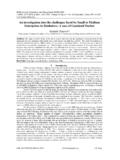Transcription of Cohabitation, Marriage and Remarriage Patterns in Africa
1 cohabitation , Marriage and Remarriage Patterns in Africa : A religious Viewpoint INTRODUCTION Africa is one continent with several worlds. Africa is home to innumerable tribes, ethnic and social groups, some representing very large populations consisting of millions of people, others are smaller groups of a few thousand. All these tribes and groups have cultures which are different, but represent the mosaic of cultural diversity of Africa . When considering any particular issue partaining to Africa it is neccesary to keep these various cultural variations in mind even in its social institutions such as in the case of Marriage . Marriage in Africa has been commonly described as early and universal and this situation has partly been blamed for the persistence of high fertility in the region. However, the region is far from homogenous.
2 Marriage Patterns vary across and within countries among different ethnic groups. Such variations could be due to both cultural and socio-economic factors. Although it varies in different African countries, however, the four main marital union can be identified as follows: Custom/traditional Marriage , religious Marriage , civil Marriage and mutual consent union/cohabitaion. The custom/traditional Marriage varies in different countries of Africa . For example, Lobola is a century-old Marriage tradition, still common throughout Africa . This system requires that a price be paid for the right to marry a woman. This practice is still used extensively in contemporary African society and has raised both critical and supportive voices. For instance, South Africa has the highest incidence of HIV/AIDS in the world, and some claim that this high rate is partly due to the custom of Lobola.
3 The custom is seen as a monetary transaction and the wife as a bought object; the husband often feels free to acquire mistresses and hence increases the possibility of infection, which in turn can be transmitted to the wife. 1 Africa is comprised of many religious and non-religious groups. The major religious cultures are Muslim, Christians (Roman Catholic, Protestant, Orthodox, Anglican and others), ethnic religionist, non-Christian, Hindu and Baha'i. Therefore, there are various religious traditions of Marriage as well. Civil Marriage is also common in some African Countries like South Africa . Samesex Marriage (Civil Marriage ) became legal in South Africa on 30 November 2006 when the Civil Unions Bill was enacted after having been passed by the South African Parliament earlier that month. Finally, cohabitation as a distinctive form of union appears to be a feature of many eastern and southern African groups, where traditional Marriage is concluded by the transfer of bride-wealth.
4 For example in Botswana, the absence of bride-wealth does not prevent unions, but they are inferior types of union, which do not transfer paternal rights to the man, nor guaranty stability or durable access to the land ( if widowed) to the woman. If she joins her partner s home, the union lasts for several years, and the man participates in the cost of raising the children, a consensual union may be said to exist. It may be a transitional stage, before bride wealth is paid and the cost of wedding feast has been saved, or it is a lifetime arrangement. Survey has shown that out of four women in their childbearing years one may be married, one lives in a stable co-resident union, and two are in visiting union. Eighty-five percent of first children are born before Marriage , and in a large majority of cases the father disappears without contributing to their upkeep. The mother s family takes them mostly in charge.
5 In the census of Botswana, 40 percent of the children under 15 are enumerated as grandchildren of the head of household. Most African countries are extremely poor and have been stagnating over the last 40 years. Several different explanations have been proposed, ranging from colonial origin and bad institutions to tropical climate and diseases. However, it has been argued that the Marriage system, as discussed above and in particular polygamy (where a man marries more than one woman) is one contributing factor to the lack of development in this region. Polygamy leads to low incentives to save, depressing the capital stock and output. 2 The number of married men in polygamous unions ranges from in Malawi to percent in Cameroon. This region is also characterized by extremely high fertility, a high age gap between spouses, and low savings rates. It has been argued that polygamy causes high fertility and low incentives to save and thereby contributes to underdevelopment in Africa mainly Sub-Saharan Africa .
6 Polygamy has been considered to be bad for economic development as well. Polygamy raises demand for wives, which increases the equilibrium bride price. While men make payments to obtain brides, a common practice in Africa , they are also the recipients of these payments when they sell their daughters. Women thus function as a good investment opportunity, providing income for retirement. Earlier in the year 2004 the World Health Organization and the UN published a series of reports looking at reasons why women might be more susceptible to HIV than men. One of the areas blamed here was again Marriage . This seemed something of a contradiction, but the idea was that young women, particularly teenage girls, married older infected men and had physical contact with their peers as well. There's also the issue of poverty, exchange of sex for material things and early Marriage .
7 Further, polygamous Marriage was also not uncommon in these areas. They also found out about a tradition called Shaking the dust where young girls, 10 or 11-years-old, were taken off to a separate hut in a corner of the village, and visited by several men who had physical relationship with them. OTHER CULTURAL AND TRADITIONAL PRACTICES Some cultural and traditional practices do have an effect on HIV transmission in some parts of Africa . Some of them are discussed below: Polygamy: In Africa , as already mentioned above, polygamy is a social practice used to ensure the continued status and survival of widows and orphans within an established family structure. Demographic and Health Surveys in Ghana (1988), Senegal (1986), Kenya (1989), and zimbabwe (1988-89) showed that the proportion of women in a 3polygamous union was 31% in Ghana, 48% in Senegal, 23% in Kenya, and 16% in zimbabwe .
8 In urban settings and other areas where traditional polygamy is no longer the norm, men tend to have many sexual partners and employ the services of sex workers. Mitsunaga and associates, a researching group of Maryland Population Research Center (MPSC), found that men who have 3 or more wives were at a high risk of engaging in extramarital sex, reinforcing the belief that men are biologically programmed to need sexual association with many women. Also putting young African girls at risk of contracting HIV is the false belief that men can rid themselves of HIV/AIDS by engaging in interaction with a virgin. As a result of this misconception, many young girls have been raped and, subsequently, infected with HIV. Widow inheritance: In many sub-Saharan African countries, a man's property, including his wife, passes to his adult sons or brothers after his death. The fate of African widows ranges from disinheritance and forceful deprivation of property to the mandatory observance of harmful rituals.
9 One of these traditional rituals is widow inheritance, a practice whereby the widow agrees to marry her husband's younger brother to continue as a member of the family. In case of refusal, she is expelled and left to care for her children alone. In a study of 92 widows whose husbands died of a chronic illness between November 1991 and October 1992 in Kenya, Okeyo and Allen found that 47 women (51%) had already been inherited, 34 (37%) had plans to be inherited, and 11 (12%) refused to be inherited for fear of spreading HIV. Comparing the sexual behaviors of inherited and uninherited widows, Agot and colleagues, a research group, found that inherited widows were more likely to be sexually active (odds ratio [OR] = ; 95% confidence interval [CI] = ), to have sex with casual partners (OR = 7; 95% CI = ), and to engage in ritual sex (OR = ; 95% CI = ), but the difference between the 2 groups with regard to HIV seroprevalence was not significant.
10 If a man died of AIDS and had infected his wives, the younger brother(s) will in turn become infected. However, a younger brother may be HIV-infected and, upon marrying his deceased brother's wife or wives, he will infect her or them 4 Male Circumcision: Data from Africa showed that countries in which fewer than 20% of males are circumcised, such as zimbabwe , Botswana, and Zambia, experience a high prevalence of HIV infection (greater than 19%), whereas countries in which more than 80% of males are circumcised, such as Cameroon, Gabon, and Ghana, have a lower prevalence of HIV infection (less than 10%). Moreover, preliminary results from a South African randomized trial showed that male circumcision can reduce the risk of contracting HIV by 70%, a level of protection far better than the 30% risk reduction set as a target for an AIDS vaccine. Inungu and colleagues summarized the mechanisms thought to explain the protective effects of male circumcision.


![Index [www.tongaat.co.za]](/cache/preview/f/7/7/5/c/d/4/1/thumb-f775cd41d646a3d64d3ce917aaad62e5.jpg)


